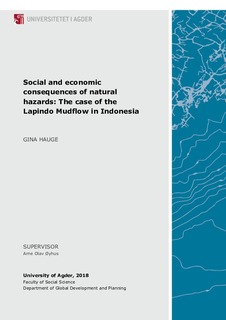| dc.contributor.author | Hauge, Gina | |
| dc.date.accessioned | 2018-10-02T07:45:06Z | |
| dc.date.available | 2018-10-02T07:45:06Z | |
| dc.date.issued | 2018 | |
| dc.identifier.uri | http://hdl.handle.net/11250/2565627 | |
| dc.description | Master's thesis Global development and planning UT505 - University of Agder 2018 | nb_NO |
| dc.description.abstract | In the end of May 2006, a quite special volcano erupted in the Sidoarjo regency on East Java, namely the Lapindo mudflow. The consist of hot mud, gases and water at about 100 degrees Celsius. In 2008, the mudflow covered 816 hectares of land, covering both villages and agriculture. Experts are still discussing if the eruption was caused by an earthquake that had its epicentre 200 km west from where the eruption took place, or if it was caused by the drilling that Lapindo Brantas was doing in the area.
The Lapindo mudflow triggered a social and environmental crisis where 12 villages were covered by mud and 40,000 people had to be evacuated. This research has explored the social and economic consequences the Lapindo mudflow have had for the local communities that have been affected by this disaster.
In March 2007, the government released the map they had drawn that determined which regions that would be included and not in the disaster zone of the mudflow. The victims can be categorised the into three groups, and these are: in-map victims, out-map victims and the non-victims. The in-map got their compensation from Lapindo Brantas, the out-map victims got their compensation from the government, and the non-victims that do not have legal status as victims. I consider them as victims because they are living in an environment that is degraded from gases and environmental damages like loss of clean water, falling dirt and gases that contains the air. | nb_NO |
| dc.language.iso | eng | nb_NO |
| dc.publisher | Universitetet i Agder ; University of Agder | nb_NO |
| dc.rights | Attribution-NonCommercial-NoDerivatives 4.0 Internasjonal | * |
| dc.rights.uri | http://creativecommons.org/licenses/by-nc-nd/4.0/deed.no | * |
| dc.subject | UT505 | nb_NO |
| dc.title | Social and economic consequences of natural hazards : The case of the Lapindo Mudflow in Indonesia | nb_NO |
| dc.type | Master thesis | nb_NO |
| dc.subject.nsi | VDP::Samfunnsvitenskap: 200::Statsvitenskap og organisasjonsteori: 240::Offentlig og privat administrasjon: 242 | nb_NO |
| dc.source.pagenumber | 78 p. | nb_NO |

